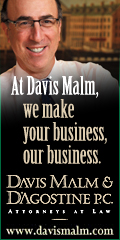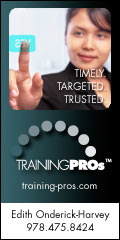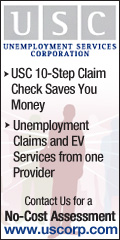NEHRA News
Northeast Human Resources Association
Massachusetts Governor Deval Patrick wasn’t making empty campaign promises when he went public with a commitment to increase diversity in the state’s workforce. Within thirty days of his inauguration, Governor Patrick had issued Executive Order 4781, recommitting the Commonwealth to, among other objectives continued improvement in the recruitment and retention of under-represented groups of people in the workforce, including people with disabilities. And he backed up that commitment with a promise to act locally, by making the state government a model employer of people with disabilities.
With the creation of the Massachusetts Task Force on Employment for People with Disabilities, a first step was taken towards realizing that vision. In June, 2009, the Task Force delivered a Strategic Plan outlining 25 objectives designed to achieve the overarching goal of creating an inclusive environment that recruits, retains, and promotes people of all abilities.
The so-called Model Employer Initiative was challenged early on by the discovery that there was little hard data on the number of people with disabilities already employed in state government. While there was an assumption that many current employees had unreported disabilities, there was also recognition that misinformation about possible impacts on their job status, coupled with a lingering fear of stigma, prevented many people with disabilities from self-identifying. In response to these misconceptions, the Taskforce created a marketing campaign to raise awareness of the prevalence of disability in the workplace, to emphasize the value of employees with disabilities, and to encourage state employees with disabilities to self-identify. This campaign featured boldly-colored posters with a powerful core message:
CLICK HERE TO VIEW THE AD CAMPAIGN
The campaign was set to roll out in October, timed to coincide with National Disability Employment Awareness Month.
Raising Awareness
The key to bringing about the desired culture shift to an atmosphere of inclusion begins with raising awareness of the issues surrounding disability employment. The Model Employer Initiative takes a two-pronged approach to raising awareness:
-
Mandatory training – Curricula tailored to the needs of different stakeholder groups forms the basis for mandatory training in disability employment issues. For employees, the training focuses on basic facts and myths surrounding disability, and outlines proper etiquette for interacting with people with disabilities. More specialized trainings for managers and American with Disabilities (ADA) coordinators look at roles, policies and practices in recruiting, hiring, and accommodating employees with disabilities.
-
Effective Communication – Dialogue, a quarterly newsletter that highlights disability employment issues, is distributed electronically to the entire executive branch, approximately 44,000 employees. The publication features timely topics such as assistive technologies and ADA provisions, as well as profiles of individual employees who are working with disabilities. In addition to the online version, the newsletter is made available in alternative formats.
Creating Opportunities
The Model Employer Initiative includes strategies for increasing the number of people with disabilities who are hired by the Commonwealth. Finding qualified candidates requires:
- Internship Program – Summer internship programs, which began in 2009, offers skills training and resume building to students with disabilities, while giving the Commonwealth the benefit of a largely untapped talent pool and helping to create an inclusive environment.
- Relationship Building – In order to increase opportunities for recruitment and promotion of employees with disabilities, the Task Force has worked to build strong relationships with the state’s vocational rehabilitation agencies, the Massachusetts Rehabilitation Commission (MRC) and the Massachusetts Commission for the Blind (MCB). These two agencies are natural partners for the Disability Employment Initiative, since they are the front-line service providers for people with disabilities who seek employment.
Providing Support
The Employment Initiative backs up its outreach efforts to the various state agencies with tangible support in the form of financial assistance when needed to implement necessary accommodations for employees with disabilities. Through the Reasonable Accommodation Capital Reserve Account (RACRA), administered by the Office on Disability, state agencies may apply for funds to help with capital expenditures on such things as assistive technology, physical barrier removal, and office adaptations. There is a pervasive myth that providing reasonable accommodations for employees with disabilities is expensive. Research conducted by the Job Accommodation Network, a non-profit agency, suggests that well over half of accommodations cost nothing, and that the average cost of a one-time accommodation (for example, for assistive devices) is $600. An analysis of RACRA funds expended since 2009 supports this claim, with the most costly accommodations averaging just over $500.
Measuring Success
The lifespan of the Massachusetts Model Employer Initiative has, unfortunately, coincided with a period of economic downturn across the Commonwealth. Still, despite workforce reductions, the percentage of state workers who have disabilities has held steady at around 2.8%. Furthermore, the distribution of self-identified employees with disabilities shows a majority of those employees hold professional positions, dispelling the myth that people with disabilities tend to be employed at lower levels.
The number of state employees self-identifying as having a disability has increased steadily since the initiative began in 2009, suggesting that the targeted marketing campaign has succeeded in raising awareness of the benefits of standing up and being counted.
The final measure of success will be when the initiative is fully embedded in the infrastructure of state government. With a combination of ongoing support from the state’s top leadership, and consistently effective communications strategies, Massachusetts stands an excellent chance of indeed being a model at the national level for employment of people with disabilities.
References:
1In February 2011, Governor Patrick issued Executive Order 526 as a replacement to Executive Order 478. Executive Order 526 expanded the protected class members.
About the Author:
Missy Hall Nicholson is from Work Without Limits, a public/private initiative whose mission is to strengthen the Massachusetts workforce and advance work opportunities for youth and adults with disabilities. Their website, www.workwithoutlimits.org, offers a wealth of resources related to employment issues. Missy can be reached via email at missynich@verizon.net.
These circumstances can be minimized during the initial hiring process by using several techniques including effective recruitment programs, skilled interviewing and in-depth work style and personality assessment tests. An in-depth assessment is a highly effective tool and an efficient use of company resources at this crucial point of the decision making process.
This article focuses on in-depth assessment tests and how your company can benefit from them during the interview process, before a potential new hire turns into the wrong decision. An in-depth profile, in conjunction with a thorough interview process and good background check, can reduce the possibility of a hiring error. It also can provide your company with quantifiable information on a candidate’s specific strengths and weaknesses. Moreover, an assessment will offer objective, expert guidance on how best to manage and place that individual within your organization.
Personality Assessment Testing – A Standard in Recruiting
In-depth work style and personality assessments are a standard recruiting practice for many branches of the government and military, as well as many Fortune 500 companies when assessing potential hires for key or critical positions. They are used to reduce employee turnover and improve department effectiveness. Correctly interpreted, professionals can help guide your organization on how to best manage, communicate and train new hires and staff members.
As with any business decision, having the right information is critical. Work style and personality assessment testing can provide insight into potential hires, as well as your current workforce, in several ways:
Which Assessment Tool Should My Organization Use? The following are some things to think about when reviewing various work style & personality profiles:
These are some general questions and if a profile falls short in any one area, we strongly suggest additional research into the accuracy of the data being generated. Frequently Asked Questions A frequent question from companies and organizations concerns the legal guidelines in administering assessments to potential employees. Industry regulations can vary and the best option is to consult with your company’s trade association or legal department. As a general rule, if your company uses an assessment, any test or set of hiring questions must be administered to all of the final candidates in order to assure that discrimination is not present. Additional information can be found online at the EEOC website, in the Disability-Related Inquiries and Medical Examinations of Employees section: http://www.eeoc.gov/laws/types/disability.cfm. An additional question concerns how a new hire may feel about taking an in-depth personality and work style assessment. There is a certain amount of "test anxiety" that can be common. However, the test demonstrates that your company is serious about who they hire. If your company explains that the goal of the assessment is to reduce turnover and is only one of several factors involved in the hiring decision, the individual usually responds very well. In many cases, the candidate may accept a position from the organization they perceive to be more thoughtful during the hiring process. Conclusion An in-depth assessment is only one component needed for a successful recruitment and hiring program. It can provide valuable information for critical personnel decisions. Combined with an effective recruitment program and skilled interview techniques, it can benefit your company as a whole, in addition to your individual employees. Armed with accurate and quantifiable data from an in-depth personality assessment, the interview process becomes much more reliable. Ultimately, this only adds to your organization’s bottom line, allowing more effective management of your existing workforce and limiting the potential for wrong hiring decisions.
About the Author:
Dana Borowka, MA has over 25 years of experience in business consulting. He has an undergraduate degree in Human Behavior and a masters degree in Clinical Psychology. She can be reached at dana@lighthouseconsulting.com.
It will also ensure that your information is correct in the Member Directory. Once you log in, go to the "About NEHRA" tab and select Membership Directory and then click on Update my Membership Profile.
While you are updating your profile, you might want to consider joining one of the Community Forums or adding your name to one of the Listservs. An updated profile and connecting to one of the NEHRA Communities is a great way to maximize your membership and create your personal network.
If you need help with this process please do not hesitate to contact Carole Edson, Director of Membership, at cedson@nehra.com.
- To become a fan of NEHRA on Facebook, CLICK HERE.
- If you are already a member of LinkedIn, CLICK HERE to join the NEHRA LinkedIn Community!
If you are not already a member of LinkedIn, you will need to follow the easy steps to create your profile. Once your profile is completed you can follow the steps below to become a member of the Northeast Human Resources Group.
- Find the tab for "Groups" on your home page and select "Group Directory."
- Use the search function in the upper right and type in "Northeast Human Resources Association."
- Click on "Join this Group."
- This will bring you to a description of the group and you will be asked to make selections about your preferences for display the group logo on your personal page.
- Enter a contact email address, a digest e-mail address, delivery frequency, announcements and messages.
- Once you have made these choices click the button "Join Group."
- Your message will come to the NEHRA Group Administrator to verify membership and approve you for the group.
To Join a Community Forum Subgroup on LinkedIn
- Once you are a member of the Northeast Human Resources Group, select "Subgroups."
- Select all the groups you are interested in joining.
- Your request goes to the NEHRA Group Administrator for approval.
- You will receive a message that you are a member of this subgroup and you can begin to read and post information on the Subgroup page.
Current NEHRA Subgroups
- Learning and Development Community Forum
- Diversity and Inclusion Community Forum
- Consultants Community Forum
- Small Business HR Community Forum
- HR Technology Community Forum
- Talent Acquisition Community Forum
- Flexible Workplaces Community Forum
The companies or Employment Partners benefit by outsourcing a full-time, entry-level, professional job to one team of four students who share the job. The NDHS student workers are an innovative resource that enables organizations to increase their diversity and to make a real impact on the workforce of the future without adding to their roster of full-time employees. Many Employment Partners really value the energy that the student workers bring to their companies.
As NDHS continues to grow, the CWSP seeks additional Employment Partners for our students. To learn more about the CWSP and how it can benefit your company, please go to www.ndhslaw.org/corporate-work-study-program.
For more information or to sign up for this opportunity, contact the NEHRA office today at (781) 235-2900 or via email at info@nehra.com.



